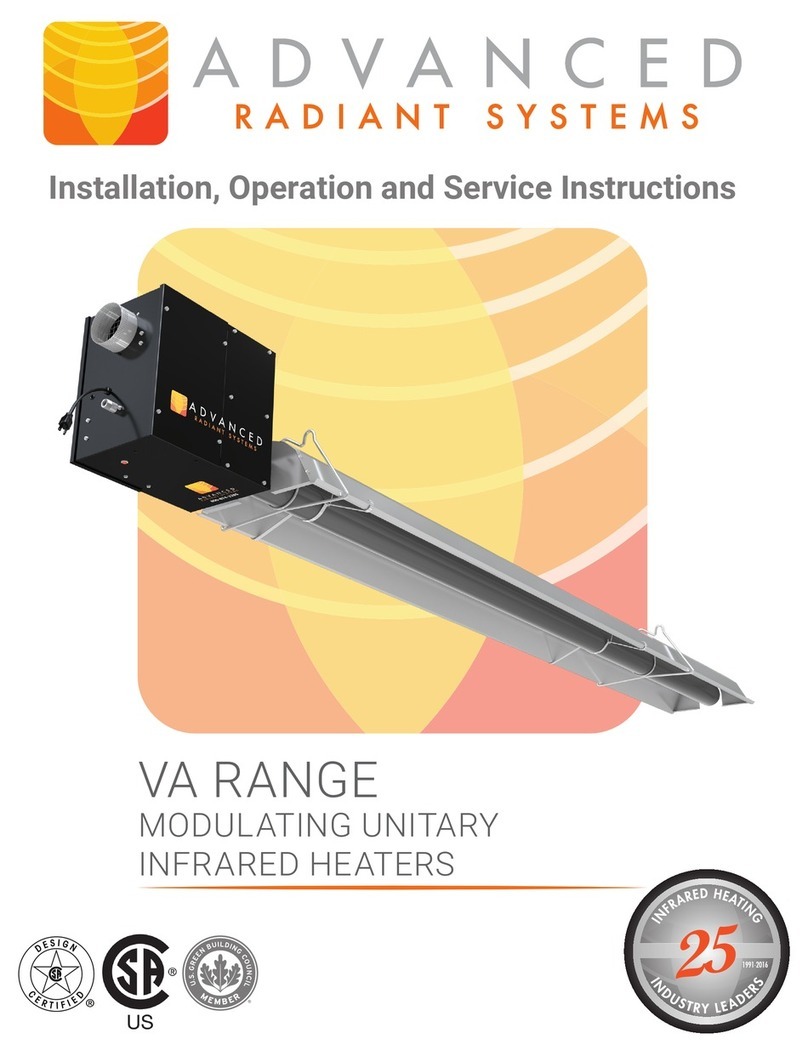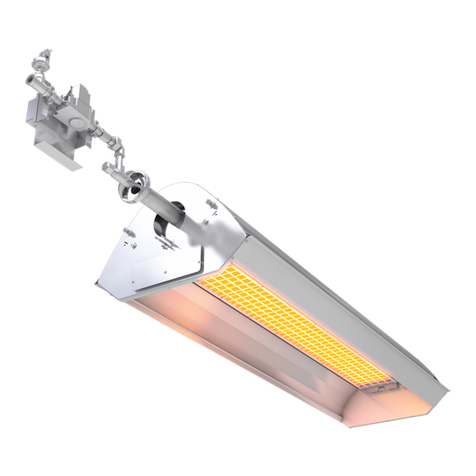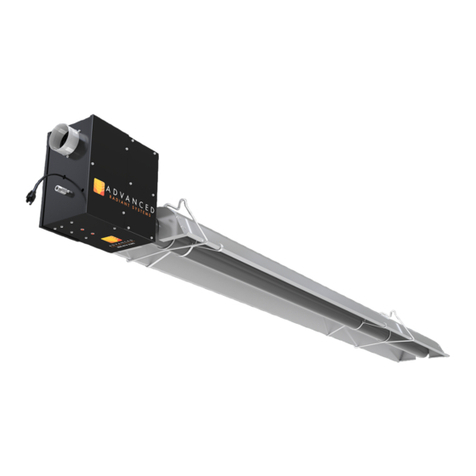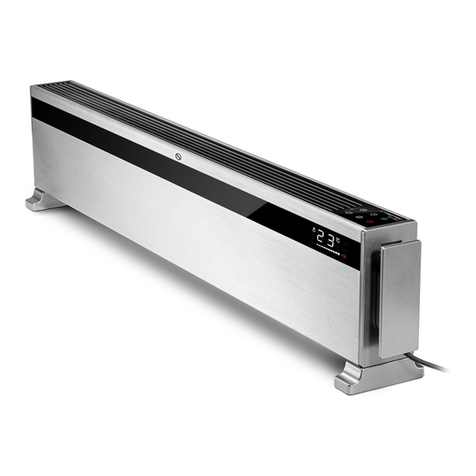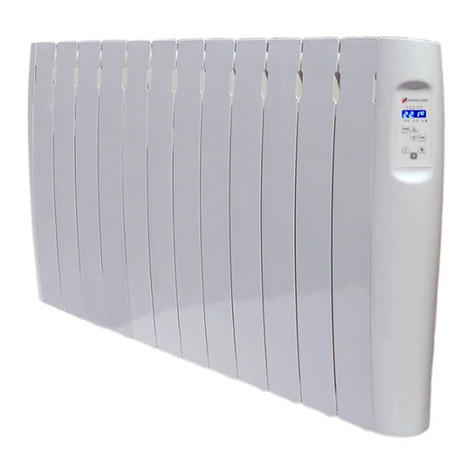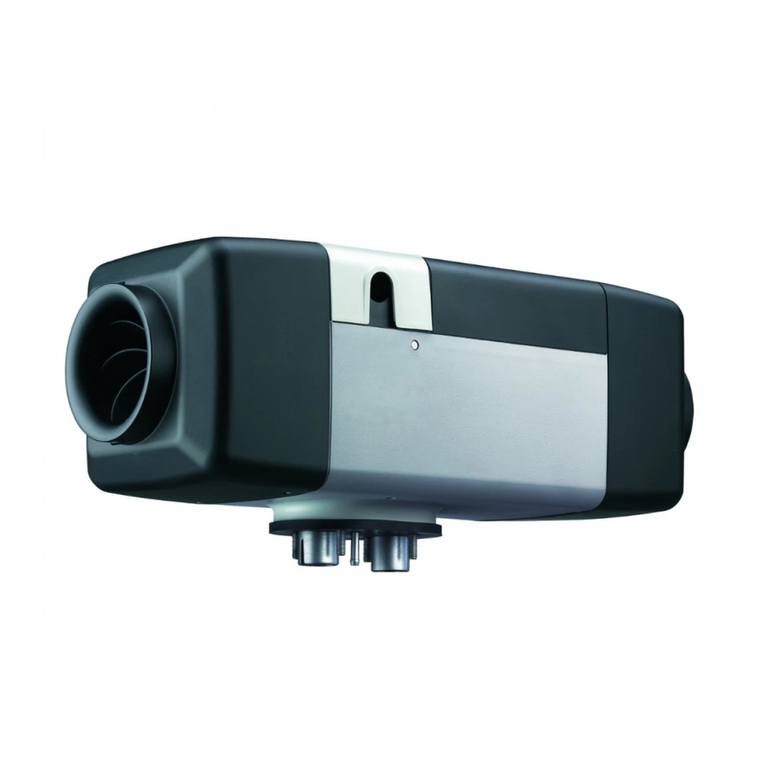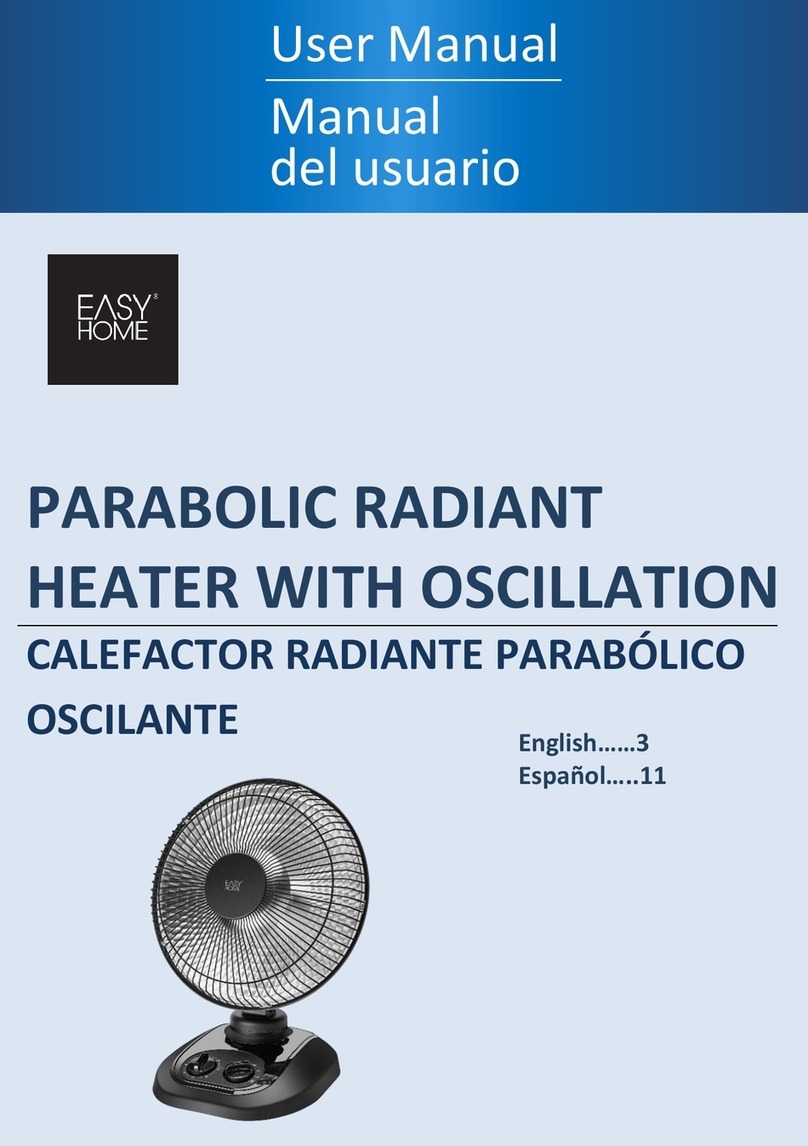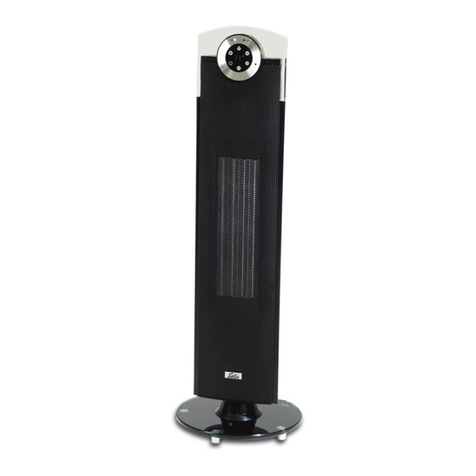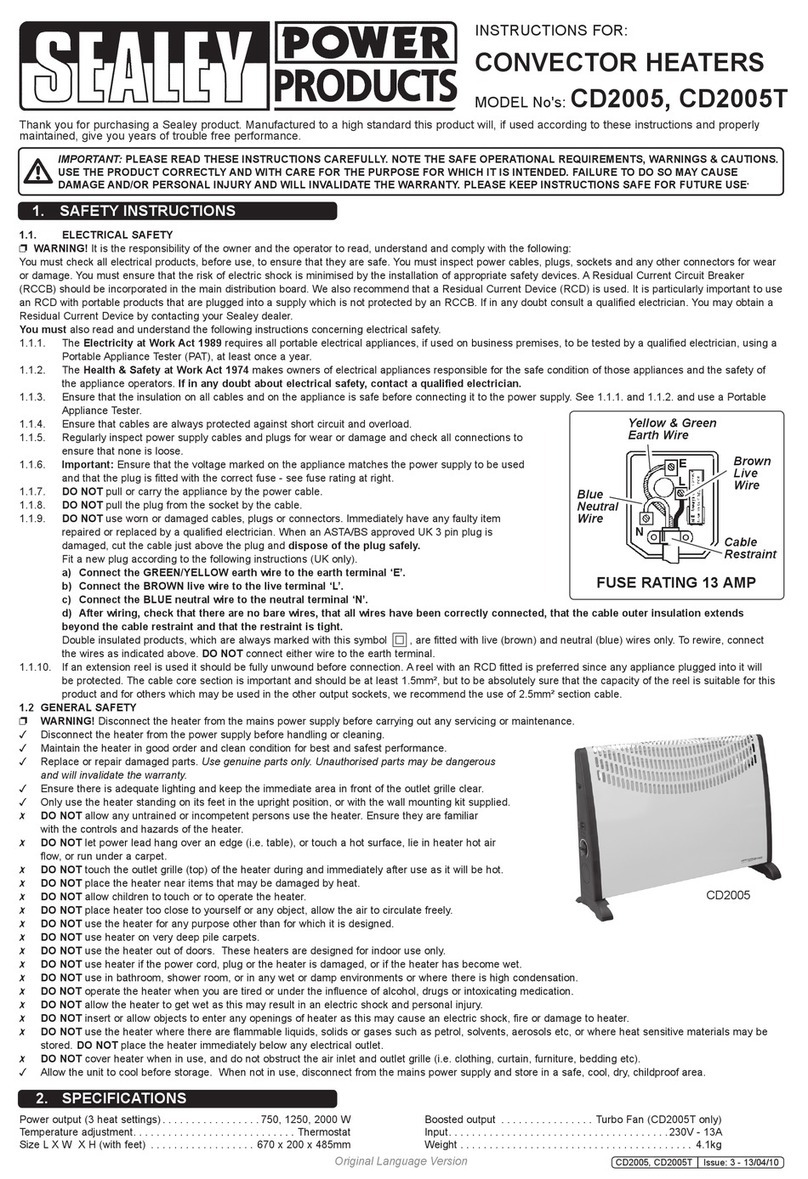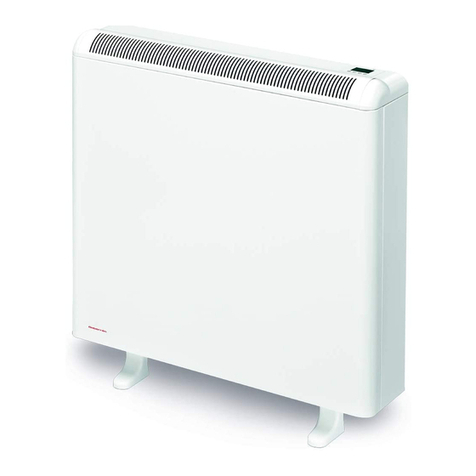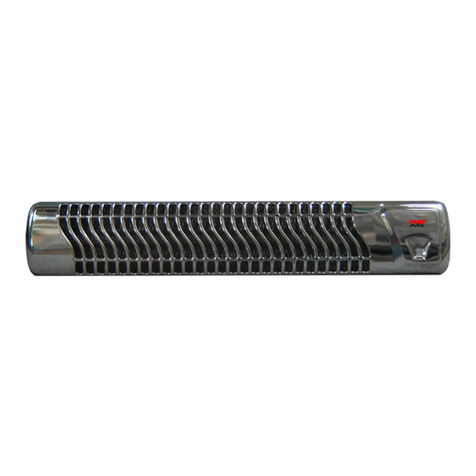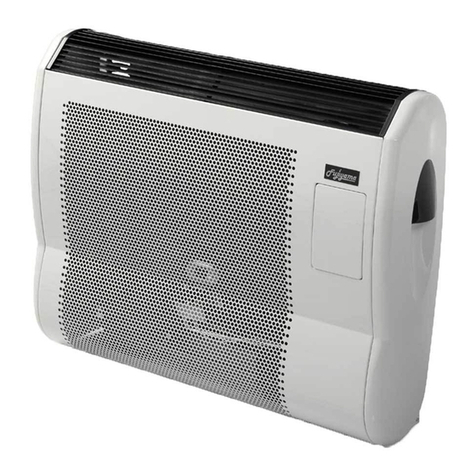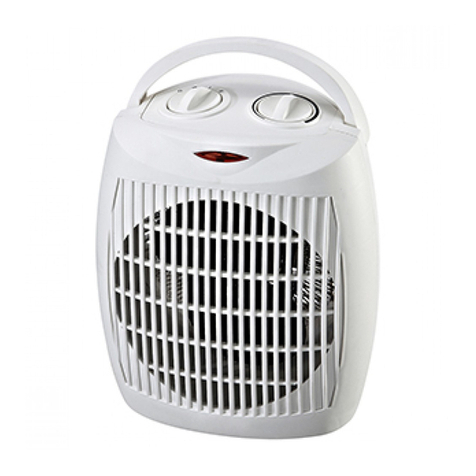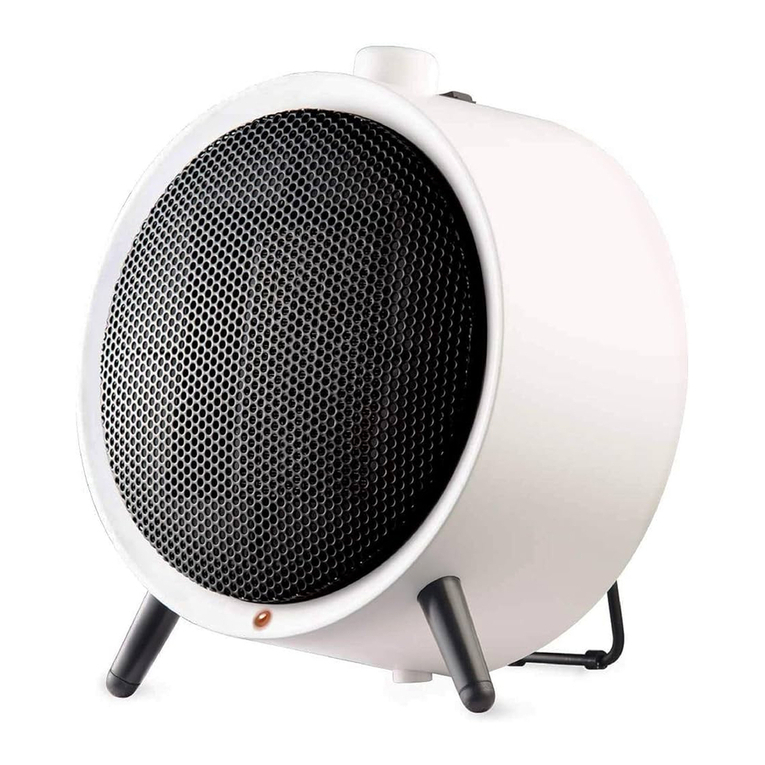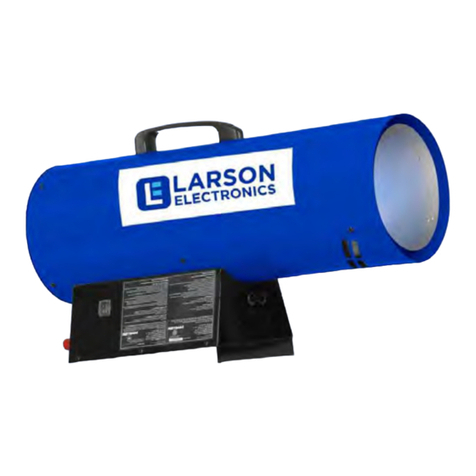Advanced Radiant Systems RS-30 Manual

Installation, Operation and Service Instructions
RS RANGE
RESIDENTIAL
INFRARED HEATERS


WARNINGS
WARNING
Improper installation, adjustment, alteration, service
or maintenance can cause property damage, injury
or death. Read the installation, operating and
maintenance instructions thoroughly before
installing or servicing this equipment.
FOR YOUR SAFETY
Do not store or use gasoline or other flammable
vapors and liquids in the vicinity of this or any other
appliance. If you smell gas:
1. Open windows
2. Don’t touch electrical switches
3. Extinguish any open flame
4. Immediately call your gas supplier
OWNER
Retain this Manual & ensure available for service.
Improper installation, adjustment, alteration, service
or maintenance can cause injury, death or property
damage.
Read the installation, operation and service
instructions thoroughly before installing or servicing
this equipment.
INSTALLER
Provide Manual to Owner upon completion of
installation!
Read and thoroughly understand these Instructions
before attempting any installation
CAUTION: FIRE OR EXPLOSION HAZARD
Maintain clearance to combustible constructions as
further specified in this manual. Failure to do so
could result in a serious fire hazard. Heaters should
not be located in hazardous atmospheres containing
flammable vapors or combustible dusts. Signs
should be provided in storage areas specifying
maximum safe stacking height.
CAUTION: MECHANCIAL HAZARD
This equipment expands and contracts with each
operating cycle. The gas connection, suspension
hardware and the installation itself must safely allow
this movement. Failure to do so could result in
serious fire or explosion hazard.
CAUTION: FIRE OR EXPLOSION HAZARD
This heater is equipped with an automatic ignition
device. Do not attempt to light the burner by hand.
Failure to comply could result in a serious fire and
personal injury hazard.
CAUTION: MECHANCIAL HAZARD
Do not use high pressure (above 1/2 psi) to test the
gas supply system with the burners connected,
doing so could result in damage to the burner and
its control components requiring replacement.
Do not install equipment in atmospheres containing
halogenated hydrocarbons or other corrosive
chemicals, doing so may lead to premature
equipment failure and invalidation of the warranty.
Additionally, it is recommended that the equipment
be installed with a slope downward and away from
the burner of ¼" (6mm) in 10' (3m) to allow start-up
condensate drainage.
CAUTION: SERVICE LIFE RISK
Due to continuous product innovations, we reserve the right to change product specifications without due notice.

CONTENTS
INTRODUCTION ............................................................................................................................. 1
Installation Codes.............................................................................................................................................1
GENERAL SPECIFICATIONS .......................................................................................................... 2
DIMENSIONAL CHART .................................................................................................................. 2
CLEARANCE TO COMBUSTIBLES ................................................................................................. 3
INSTALLATION .............................................................................................................................. 4
Installation Sequence.......................................................................................................................................4
Outdoor Installation..........................................................................................................................................5
Cover Installation Sequence............................................................................................................................7
DECORATIVE GRILLE .......................................................................................................................................9
VENTING AND COMBUSTION AIR DUCTING .............................................................................. 10
General Requirements ...................................................................................................................................10
Roof Venting ...................................................................................................................................................12
GAS PIPING.................................................................................................................................. 13
General Requirements ...................................................................................................................................13
ELECTRICAL WIRING................................................................................................................... 14
General Requirements ...................................................................................................................................14
Wiring Diagrams .............................................................................................................................................14
OPERATION AND MAINTENANCE............................................................................................... 15
Starting Sequence of Operation....................................................................................................................15
Maintenance ...................................................................................................................................................15
TROUBLESHOOTING ................................................................................................................... 16
Troubleshooting Chart ...................................................................................................................................17
REPLACEMENT PARTS ............................................................................................................... 18
WARRANTY.................................................................................................................................. 19

Page 1Residential Range RS_10062016al
Advanced Radiant Systems’ Residential Range (RS) is exactly what it sounds like; a residential grade,
unitary infrared heater. The RS is designed to optimize performance as well as aesthetics. The compact,
preassembled, unitary design and custom mounting brackets make for a simple and minimally invasive
installation. With lower output capacities, comfortable designs are easily maintained at lower hanging heights.
INTRODUCTION
IMPORTANT
These instructions, the layout drawing, local codes and ordinances, and applicable standards such as apply to
gas piping and electrical wiring comprise the basic information needed to complete the installation, and must
be thoroughly understood along with general building codes before proceeding.
Only personnel who have been trained and understand all applicable codes should undertake the installation.
Representatives that are Factory Certied in the service and application of this equipment and can be called on
for helpful suggestions about installation.
Installation Codes
Installations must comply with local building codes, or in their absence, the latest edition of the national
regulations and procedures as listed below.
General Installation and Gas Codes
Heaters must be installed only for use with the type of gas appearing on the rating plate, and the installation must
conform to the National Fuel Gas Code, ANSI Z223.1/NFPA 54 in the US and CSA B149.1 and B149.2 Installation
Codes in Canada. This heater may be approved for either indoor or outdoor installation. Not for use in residential
dwellings, refer to Rating plate.
Aircraft Hangar Installation
Installation in aircraft hangars must conform to the Standard for Aircraft Hangars, ANSI/NFPA 409 in the US and
CSA B149.1 and B149.2 Installation Codes in Canada.
Public Garage Installation
Installation in public garages must conform to the Standard for Parking Structures, NFPA-88A or Standard for
Repair Garages, NFPA 88B, in the US and CSA B149.1 and B149.2 Installation Codes in Canada.
Parking Structures
Technical requirements are outlined in ANSI/NFPA 88B (USA)
Electrical
All heaters must be electrically grounded in accordance with the National Electric Code, ANSI/NFPA 70 in the US,
and the Canadian Electric Code, CSA C22.1 in Canada, and must comply with all local requirements.
Venting
Refer to the National Fuel Gas Code, ANSI Z223.1 (NFPA 54) in the US and CSA B149.1 and B149.2 Installation
Codes in Canada, as well as all local requirements for general venting guidance.
High Altitude
When installing this appliance over 4500 ft. above sea level in Canada, the appliance must be properly derated
and installed according to local codes. In the absence of local codes the appliance must be derated in
accordance with the most recent CSA B149 code. In the United States for installations over 2000ft above sea
level the appliance must be installed in accordance with the Current National Fuel Gas Code, ANSI Z223.1/NFPA
54.
Safety Features
This heater utilizes an airow switch as blocked vent shut off system. This system is designed to prevent the
operation of the appliance if a fresh air supply is blocked or if the ue exhaust is blocked. If this system fails to
operate DO NOT ATTEMPT ADJUSTMENTS. Disconnect power to the appliance and contact a qualied service
person.

Page 2Residential Range RS_10062016al
GENERAL SPECIFICATIONS
DIMENSIONAL CHART
Gas Supply
Inlet Pressure
Natural Gas: Minimum 5.0" W.C.
Maximum 14.0" W.C.
Propane Gas: Minimum 11.5" W.C.
Maximum 14.0" W.C.
Manifold Pressure
Natural Gas: 3.5" W.C. Propane Gas: 10.5" W.C.
Inlet Connection
Natural Gas or Propane: 1/2" NPT female
Electric Supply
120 VAC, 60 HZ, 1 Amp: 36" cord with grounded 3 prong plug
Flue and Outside Air Connection
2" diameter (installed concentrically)
Figure 1: Overall Dimensional Information
RS-30 RS-45
30,000 45,000
109 LBS
REFER TO ANSI Z223.1 AND CSA B149.1 AND B149.2 FAN ASSISTED
APPLIANCES FOR CORRECT SIZING.
NOT TO SCALE
15.1"
7.5"
5
"
3.8"
1.8"
5.4"
113.0"
6.4"
1.0"
3.8
"
5.
Table 1: Heater Specications

Page 3Residential Range RS_10062016al
CLEARANCE TO COMBUSTIBLES
It is very important to observe the minimum clearance to combustibles at all times to avoid any possibility of
property damage or personal injury.
WARNING
Clearances as marked on the heater body must be maintained from vehicles parked beneath.
Signs should be posted identifying any possible violation of the clearance distances from the
heater in all vehicle areas.
appropriate markings adjacent to the thermostat or in a conspicuous location.
Table 2 lists the minimum clearance to combustible materials for various installation congurations. Note
that standard clearances also apply to installation above T-bar ceilings and above decorative grills. Additional
clearance may be required for glass, painted surfaces and other materials which maybe damaged by radiant or
convective heat.
Combustible materials are considered to be wood, compressed paper, plant bers, plastics, Plexiglas or other
materials capable of being ignited and burned. Such materials shall be considered combustible even though
ameproofed, re-retardant treated or plastered.
Reector miter kits are available for U-bends and elbows.
Adequate clearance to sprinkler heads must be maintained (NFPA 13: Standard for the Installation of Sprinkler
Systems).
The stated clearance to combustibles represents a surface temperature of 90°F (32°C) above room temperature.
Building materials with low heat tolerance (such as plastics, vinyl siding, canvas, tri-ply, etc…) maybe subject
to degradation at lower temperatures. It is the installer’s responsibility to assure that adjacent materials are
protected from degradation.
It is important to observe minimum clearance to combustibles at all times to avoid any possibility of property
damage or personal injury. Clearances must be maintained from vehicles parked beneath heaters. Signs should
be posted identifying any possible violation of the clearance distances from the heater in vehicle areas. Also
maximum allowable stacking height in storage areas should be identied with signs or appropriate markings.
Table 2 shows minimum clearance to combustible materials.
Table 2: Clearance to Combustibles
MODEL
NUMBER
DIMENSION
0° ANGLE 45° ANGLE VENTED
A B C D A B C D END
RS-30 18" 36" 18" 18" 50" 18" 5″
RS-45 2" 33" 33" 48" 48" 5″
C
D
A
B
D
A
B
C
in the U.S. and 7 feet in Canada.

Page 4Residential Range RS_10062016al
INSTALLATION
96.00"
Fasten Support Angle to Ceiling to
Accommodate Heater Hanging Points
OR
Note:
Close all open ended "S" hooks, chain links,
and turnbuckles or any open connection.
Figure 2: General Overview of Components Utilized in the Installation
Installation Sequence
The heater is sent with all parts necessary for installation with the exception of chain.
It is recommended that the heater be hung as high as possible and along an uncluttered wall to give the reector
a widest possible “view” of the space to be heated. Avoid installation directly over vehicle parking, over cabinets, or
where an open door will interfere. Adhere to minimum clearances on the rating plate.
Leave adequate space around the burner box for future servicing.
Choose a location that permits easy installation of exterior venting. A horizontal vent length up to 10' feet is
allowed. For vertical venting adhere to local venting tables and methods.
As required, fasten hanging angles to ceiling such that heater-hanging points can be accommodated.
Each hanging point must be able to hold at least 150 lbs.
Allow for movement of heater during expansion and contraction during operating cycle.
Heater must re horizontally. To tilt reector at 45°, lengthen two of the hanging points to an appropriate length
using chain. (Each chain length will be approximately 12" inches longer than the high side of the heater. “Quick
hooks and turnbuckles are used, the open ends must be closed to avoid unhooking chain with inadvertent
contact.

Page 5Residential Range RS_10062016al
24"
24"
SIDE
BACK
TOP 8"
Note:
Close all open ended "S" hooks, chain links,
and turnbuckles or any open connection.
Figure 3: Outdoor Heater Installation
INSTALLATION
Outdoor Installation
For outdoor installations the heater must be installed not more than 8” from beneath awnings, and not less
than 24” from back and side as shown in Figure 4. If the heater cannot be protected from the elements by an
overhang, then a protective cover must be installed as shown in Figure 7, Figure 8 and Figure 9.
When the heater is installed with back and side dimensions greater than the minimum of 24” then the
clearance.
Example:
Given: Side dimension = 36"
Back dimension = 48"
A ratio of 3:1 must be maintained
The side dimension gives us a maximum Top dimension of (36/3)" = 12"
The back dimension gives us a maximum Top dimension of (48/3)" = 16"
The new Top dimension is 12", the lesser of the two.

Page 6Residential Range RS_10062016al
INSTALLATION
24.00" Min. or ("B") 8.39" or ("B/3") Max.
28.00" Min. or ("B") 8.00" Max. or ("B/3") 28.00" Min. or ("B") 8.00" Max. or ("B/3")
Figure 4: Mounting Distances for Outdoor Installations under Eaves
Figure 5: Mounting Distances for Tilted (45°) Outdoor Installations under Eaves.
In the case where the heater is installed at a 45° angle, the minimum dimension inside the overhang is 28"
from both the back and side of the burner box and 8" maximum on the top. If the side or back dimensions are
increased then the top clearance may be increased using the same rules as for a horizontal installation.
NOTE: These dimensions are only for satisfying outdoor heater positioning. Clearance to combustible must

Page 7Residential Range RS_10062016al
INSTALLATION
Cover
2
Right Support
Bracket, Install
Screw on
Bottom Hole
Left Support
Bracket, Install
Screw on
Top Hole
1Install Both
Top Covers
As Shown,
Then Install
Assembly on
to Heater
Install Bottom
Cover As Shown
Back
Side
Front
5
4
3
Install 45°
Extension
Covers
As Shown
Attach Cover
Bracket
3
A
B
Note:
Close all open ended "S" hooks, chain links,
and turnbuckles or any open connection.
Figure 6: Cover Installation Sequence Steps 1 and 2
Figure 7: Cover Installation Sequence Steps 3 to 5
Cover Installation Sequence
When a heater is installed outdoors without the presence of an adequate eave, then a protective cover must be
installed as illustrated below. This cover is available from your local dealer (Part # RS020).
1. Install support brackets on to heater covers as shown in step 1 in Figure 6.
2. Preassembled the cover and its top covers and bottom cover as shown in step 2 in Figure 6.
3. Remove the two top screws holding the reector in place.
4. Slide cover onto burner making sure the support brackets slide into slots on the bottom cover.
5. Secure cover to heater by screwing in the cover bracket in step 3B in Figure 7.
6. Install the extension covers (Front, Back, and Side) as shown in step 4 in Figure 7 if needed
When a heater is to be installed outdoors at 45° without the presence of an adequate eave, an extension cover
must be used to protect the heater, refer to step 4 in Figure 7. This extension cover is available through your local
Dealer (Part # RS021). Note that both the cover and extension cover must be used in this case (refer to Figure 8
for completed assembly)..

Page 8Residential Range RS_10062016al
INSTALLATION
Extension Cover
Note:
Close all open ended "chain links,
and turnbuckles or any open connection.
Figure 8: Extension Cover for 45° Outdoor Installations

Page 9Residential Range RS_10062016al
INSTALLATION
DECORATIVE GRILLE
Follow these steps for the installation of the optional decorative grille.
1. Screw Decorative Grille
supports (4) to the outside of
2. Maneuver grille (2) inside the
supports lip.
3. Butt the two grates together.
4. Install and screw support strip
into side supports.

Page 10Residential Range RS_10062016al
VENTING AND COMBUSTION AIR DUCTING
General Requirements
•Refer to the National Fuel Gas Code, ANSI Z223.1 (NFPA 54) in the USA and CSA B149.1 and B149.2
Installation Codes in Canada, as well as all local requirements for vertical venting and general guidance
for minimum distances to openings to the building.
•This equipment is of balanced ue construction and must be horizontally vented (see Figure 9). Vertical
venting is permitted, but not as a balanced ue assembly. (See roof venting)
Wall Thickness
(Max. 10")
(Min. 1")
NOTES:
1- This Heater may be rotated at 45° Tilt, but both ends of the heater must be kept at the same elevation.
2- Total Vent Length (Including One (1) Elbow) = 10'
Each Additional Elbow = 4'
Max. Number Of Elbows = 2
Wall Thimble
P/N RS006
Wall Thickness
(Max. 10")
(Min. 1")
Ø4" Combustion
Air Inlet Duct Ø2" Flue
Pipe Wall Thimble
P/N RS006
Wall Thimble
P/N RS006
Wall Thickness
(Max. 10")
(Min. 1")
Ø4" Combustion
Air Inlet Duct
Ø2" Flue Pipe
Ø4" Combustion
Air Inlet Duct
Ø2" Flue Pipe
Heater may be sloped 1
4" in 10 '
Vent Elbow Kit
P/N RT013
Vent Elbow Kit
P/N RT013
6 6 6
Figure 9: Various Venting Orientations
•A ue/air vent length of 8 feet or less is recommended, although a maximum of 10' feet is allowable
(including one elbow).
•An approved Wall Terminal that allows the air duct to pass through the wall is required. This is included
with your heater. The Wall Thimble is a zero clearance terminal for both combustible and non-combustible
walls.
•For horizontal venting where an elbow is utilized an elbow kit (Part No. RT013) must be used, refer to
Figure 9 for more details.
•The 2" inch ue pipe should extend a minimum of 6" inches beyond the end of the 4" inch wall terminal (for
horizontally vented heaters only see Figure 11). Where the vent is under an eave the 2" vent pipe must have
a minimum clearance of 7" from the centerline of the vent to the bottom of the eave, refer to
•Figure 10. However, when the 2" pipe is less than 18" from the bottom of the eave, we recommend the 2"
inch ue extend just beyond the eave to prevent the possibility of frost. (Adhere to any code requirements
for clearances to opening in the building).
•The 2”-inch ue vent is inside (concentric with) the 4” inch combustion air inlet duct. Each of the
former must be seamless and all joints must be fastened with screws and sealed with GE RTV-106 high
temperature sealant (or equivalent) refer to Figure 11. The exposed 4” combustion air intake pipe is zero
clearance throughout its length.

Page 11Residential Range RS_10062016al
Fasten Screws (Min. one "1" Screw for 2" Flue Pipe)
2" Flue Pipe
(Flue Vent)
4" Combustion Air Inlet Duct
Maximum 10 Feet of Venting
With One (1) Elbow
2" Flue Pipe Should be
Concentric with the 4"
Combustion Air Inlet Duct
Seal Joints With RTV Silicone
Fasten Screws
(Min. 2 Screws
for 4" Duct)
Seal Joints
With RTV Silicone
6.0"
Extension
Wall Thimble
Figure 10: Minimum Clearance under an Eave
Figure 11: Venting & Combustion Air Ducting
VENTING AND COMBUSTION AIR DUCTING

Page 12Residential Range RS_10062016al
VENTING AND COMBUSTION AIR DUCTING
Roof Venting
When heater is to be vented through a roof (Vertical Venting), a B-Vent adapter kit (Part # RS022) must be used.
The B-vent must be installed in accordance to the National Fuel Gas Code, ANSI Z223.1 (NFPA 54) in the USA
and CSA B149.1 and B149.2 Installation Codes in Canada. Refer to the former for correct sizing. Refer to Figure 12
for general overview.
Combustion air may be supplied from the outdoors using the material provided in the vent adapter kit (Part #
RS022) available from your local dealer. Maximum length of fresh air is 10 feet including one elbow. Fresh air
ducting is not provided in the kit.
Vertical Vent Kit
P/N RS022
For Vertical Venting Refer To
ANSI Z223.1 and CAN/CSA B149.1
and B149.2 for Fan Assisted Appliances
for Correct Sizing, Clearance and
Penetration Requirements.
B-Vent
Adapter
4" Combustion
Air Inlet Duct
4" Fresh Air Terminal
(included in vertical vent kit)
B-Vent
Flue Pipe
(Flue Vent)
The B-vent adapter must be secured with screws and sealed with high temperature silicone
sealant.
Install B-vent as per local code requirements.
Figure 12: Roof Venting / Combustion Air Ducting

Page 13Residential Range RS_10062016al
GAS PIPING
•The gas meter and service must be sufciently large to supply gas to the connected building gas load
including the heating equipment and any other gas red equipment. Additionally, the gas distribution
piping must be designed according to local and national ordinances. Generally (low pressure) systems
designed with a maximum ½ in W.C. total pressure drop meet this requirement
•Gas supply pipe sizing must be in accordance with the National Fuel Gas Code, ANSI Z223.1 (NFPA 54)
in the US and CSA B149.1 and B149.2 Installation Codes in Canada.
•Before connecting burners to the gas supply system, verify that high pressure testing of the system
has been completed. Failure to do so may expose the burner components to damaging high pressure,
requiring replacement of key components.
•Flexible gas connectors of approved type must be installed as shown in Figure 30, in one plane, and
without sharp bends, kinks or twists. A smooth loop of approximately 12 in (30 cm) in diameter is best.
Failure to install the gas connection in the approved manner will result in a hazardous and potentially
deadly situation due to the movement of the heat exchanger and burner in the normal course of operation.
General Requirements
3" (7.62 cm) Max.
Displacement
12"
(30 cm)
Heater Movement Vertical
(As Shown Below)
Alternate
Positions
Okay
CORRECT POSITIONS
INCORRECT POSITIONS
WRONG
WRONG WRONG
WRONG
Heater Movement
Heater
Movement
Heater Movement
Heater
Movement
Figure 13: Flexible Gas Connections

Page 14Residential Range RS_10062016al
ELECTRICAL WIRING
General Requirements
Wiring Diagrams
Heaters are normally controlled with the thermostat that is included with your equipment. A 24V signal is supplied
by the heater control module for thermostat connection. Refer to wiring diagram, Figure 14. A bulkhead tting
in the back panel of the control box is provided for the appropriate wire. In all cases, heaters must be grounded
in accordance with the National Electric Code, ANSI/NFPA 70 in the USA, and the Canadian Electric Code, CSA
C22.1 in Canada, and must comply with all local requirements.
If any of the original wire as supplied with the heater must be replaced, it must be replaced with wiring having a
rating of at least 105°C temperature service and 600 volts capability.
FENWALL DSI
TH
PSW
V1
IND
L1
24V
V2
GND
S1
RED
BLACK
BLACK
GREEN
PINK
BLUE
YELLOW
SENSOR
IGNITER
24V
L1
NEUTRAL
TRANSFORMER 120V
RED
BLUE
BLUEPURPLE
PURPLE
BROWNYELLOW
AIR
SWITCH
BLOWER
GAS VALVE
BLACK
BURNER
24 STAT
THERMOSTAT IS
MOUNTED EXTERNALLY
24 VAC THERMOSTAT
FENWALL DSI
TH
PSW
V1
IND
L1
24V
V2
GND
S1
RED
BLACK
BLACK
GREEN
PINK
BLUE
YELLOW
SENSOR
IGNITER
24V
L1
NEUTRAL
TRANSFORMER 120V
RED
BLUE
BLUEPURPLE
PURPLE
BROWNYELLOW
AIR
SWITCH
BLOWER
24 STAT
GAS VALVE
THERMOSTAT IS
MOUNTED EXTERNALLY
BLACK
WHEN CONNECTING 120 VAC STAT,
THE TWO BLUE WIRES USED FOR
THE 24 VAC STAT MUST BE
CONNECTED INTERNALLY.
BURNER
NOTE: THE POST PURGE FEATURE
IS NOT UTILIZED WITH THE
THERMOSTAT WIRED ON THE 120
VAC CIRCUIT. THIS OPTION ONLY
WORKS IF THE HEATER IS WIRED
WITH THE THERMOSTAT ON THE 24
VAC CIRCUIT ABOVE.
120 VAC THERMOSTAT
Figure 14: Internal Wiring

Page 15Residential Range RS_10062016al
OPERATION AND MAINTENANCE
Starting Sequence of Operation
••Turn the thermostat up. When the thermostat calls for heat, the blower motor will energize.
••When the motor approaches nominal running RPM, the air-proving switch closes and activates the ignition
module.
••The ignition module, after a pre-purge period of approximately 30 seconds, energizes the igniter. Additionally,
the gas valve is energized for this ignition trial period of 15 seconds.
••If a ame is detected, the ignition sensing rod “reads” a rectication signal and the gas valve remains
open. The sparking stops when the ame signal is established.
••If no ame is detected, the gas valve closes and a 30 sec inter-purge period begins. After the inter-purge,
the module repeats the trial for ignition period. If ame is still not established, a third and nal inter-purge
followed by a nal ignition trial cycle begins. After three trials, the module will lockout for a period of
approximately 1 hour or until reset. (Reset is accomplished by removing power from the module for at
least 5 seconds.) After this 1-hour period, the module re-attempts the full ignition sequence.
••When using a 24V thermostat and the heat requirement has been met and the thermostat opens, the burner
shuts off but the fan continues to run for approximately 30 seconds. This is referred to as a post purge. This
allows the products of combustion to be removed from the heat exchanger to avoid nuisance condensation
and increase heat exchanger life.
••When using a line voltage thermostat and the heat requirement has been met and the thermostat opens, the
burner and fan shut off with no post purge.
Maintenance
For best performance, the following minimal maintenance procedures should be performed before each heating
season:
••Before performing any service or maintenance, shut off gas and electrical supply to heater.
••Check condition of forced air blower scroll and motor. Dirt and dust may be blown or vacuumed from the
blower.
••Check condition of burner. Remove any foreign objects or debris from inside the burner box or burner cup.
••Inspect the igniter. Replace igniter if there is excessive wear or erosion, breakage or other defects.
••Check inside the heat exchanger tube visually with a ashlight. If carbon or scale are present, scrape or
otherwise remove deposits (a wire brush works well).
••Be sure the burner observation window is clean and free of cracks or holes. Clean or replace as necessary.
••Check the ue pipe for soot or dirt and reattach to the heater after cleaning as necessary.
••The heat exchanger reector sections may be cleaned by wiping with a damp cloth.
••A service agency qualied to adjust and repair infrared heaters should be engaged for service other than
routine maintenance.
••Be sure vent terminal and fresh air inlet are free from obstructions. If either pipe is restricted, the safety air
switch will not operate properly, and the heater could fail to operate.

Page 16Residential Range RS_10062016al
TROUBLESHOOTING
Blower Motor Fails To Run
•Is the thermostat calling for heat? Is there 115V at the burner receptacle?
•Check blower side door for seal. Repair if necessary
•Check blower for obstructions. Replace blower if necessary.
No Gas Supply
•Check to see if manual supply valve to heater is ON.
•Check to see if gas valve knob on heater gas control is ON.
•Supply gas pressure can be checked at 1/8” NPT pressure tapping in gas supply system.
•Is combination gas control opening? No manifold pressure indicates valve is closed. Gas pressure
downstream of gas control can be measured by connecting a manometer to pressure tap on control. If
the valve is closed, either the gas valve or the ignition module is faulty.
Burner Does Not Light
•Is spark visible through site glass during ignition trial? If no, further electrical checks by a qualied service
person are probably necessary.
•Check to see if gas lines were properly purged of air.
•Check inlet and outlet gas pressure during ignition period.
•Check for orice and air plate obstruction.
Burner Does Not Stay Lit
•Check ground wire continuity.
•Check insulation on the igniter leads.
•Measure ame signal current; it should be above 0.8 micro amps DC.
•Replace module if necessary.
This manual suits for next models
1
Table of contents
Other Advanced Radiant Systems Heater manuals
